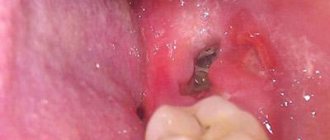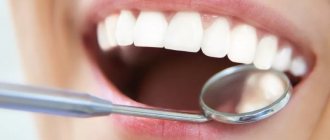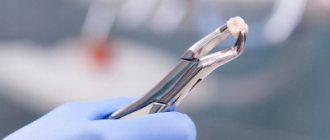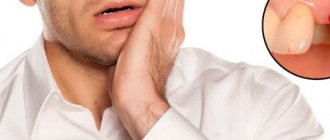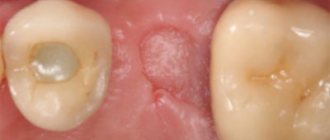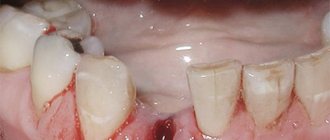Symptoms Causes Consequences Alveolitis Diagnosis and treatment Features of wisdom teeth Treatment at home Prevention
Tooth extraction is one of the most popular and simplest operations in medicine. Usually it passes without complications, but due to a number of general or subjective reasons, deviations may occur. One such postoperative complication is dry socket.
The fact is that after extraction of a tooth, a cavity forms in its place, which, in a positive scenario, is filled with a blood clot. It prevents the penetration of microbes into an open wound and promotes its speedy healing. A dry socket after tooth extraction is the absence of that same blood clot in the socket. This can happen for two reasons:
- Loss or resorption.
- Severe bleeding that prevented a clot from forming.
Whatever the reason, the healing process can take weeks and be accompanied by serious discomfort, which is not always possible to eliminate on your own.
Symptoms
Dry socket syndrome is very painful. It is quite easy to identify if the following symptoms appear within 2-3 days after tooth extraction:
- inflammation of the gums, accompanied by severe pain;
- pain in the cervical region and ears;
- the appearance of bad breath;
- taste of pus in the mouth;
- partial hearing loss;
- general malaise
Visually, a dry socket is an empty depression at the site of tooth growth, first exposing the jawbone, and then turning into a reddened, purulent wound.
Normally, the socket is a cavity that, after tooth extraction, is filled with ichor. Over the next three days, the clot thickens, and light fibrin stripes appear on it - the beginning of the formation of new gum tissue. There may be slight soreness at the wound site. From 4 to 7 days, swelling gradually subsides, and the gums acquire their usual pink color. There is no pain.
Signs of normal wound healing
After a tooth is removed, a hole is formed in the empty area in which a natural blood clot accumulates. It is very important to monitor it closely. This substance must not be removed, scrubbed, washed or dissolved. A blood clot is the most reliable protection of a wound from infection and inflammation.
Gum restoration begins 3-4 days after tooth extraction. If the operation was traumatic, the healing process lasts 5-7 days. After removal of wisdom teeth (“eights”), the healing process can exceed 10 days. The back teeth are the most “complex”, as they have many canals, so after their removal the risk of gum inflammation is especially high.
Within 5-7 days after tooth extraction, a white film appears at the bottom of the empty socket. This film is an absolutely normal reaction of the body, as protective fibrin covers the wound from “attacks” of pathogenic organisms. Just like a blood clot, the film should never be processed.
The speed of healing of the hole depends on a number of factors:
- depth of the operation performed;
- localization of the focus of the operation;
- associated dental problems;
- the state of immunity and other characteristics of the patient’s body.
If the gums are swollen and begin to bleed within half an hour to an hour after tooth extraction, this is normal. However, if the inflammation does not subside within a few hours, be sure to contact your surgeon.
Causes of dry socket
There are several causes of dry socket. Some of them can be prevented by following simple recommendations regarding personal hygiene and caution. Causes:
- smoking. In this case, there is a decrease in pressure in the oral cavity, which can lead to the loss of the formed clot;
- neglect of oral hygiene;
- low blood clotting;
- taking oral contraceptives;
- mechanical damage to the hole itself or the tissues around it.
In addition to the above reasons, a dry socket can appear as a result of an incorrectly performed tooth extraction procedure. During a complex extraction, when the tooth had to be removed from the gums in parts. All rules recommended before and after extraction must be followed.
Hygiene rules after tooth extraction
The first and important rule will be to limit brushing and rinsing your teeth immediately after surgery. You can start your usual lifestyle with daily brushing of your teeth the next day.
It is worth purchasing a brush with soft bristles at a pharmacy or store in advance, but it is still necessary to clean the area of removal with special care. Irrigator and dental floss are not allowed.
Hole hygiene deserves special attention. Dental surgeons recommend the following method for care:
- take a herbal decoction or a special rinse purchased at the pharmacy into the oral cavity;
- hold it in your mouth for several minutes, without performing any additional actions such as rolling water;
- After cleansing, you should try to refrain from drinking water and food for a couple of hours.
This action will help to avoid inflammatory processes in and around the hole, and will also reduce bleeding. Baths based on an antiseptic, for example, water-based chlorhexidine or furatsilin, will be effective.
Consequences
If during the first two days after tooth extraction pain appears, swelling does not subside and the temperature rises, then most likely these are signs of inflammation. In this case, you should immediately consult a doctor, as dry socket syndrome can lead to serious complications. Such as:
- flux.
It begins to form when an infection gets into the hole. Characterized by severe swelling and pain. Requires immediate specialist intervention. - alveolitis
This is a deeper penetration of the infection - deep into the gums. Bacteria spread quickly and, if this process is not stopped in time, there is a risk of tissue necrosis. In this case, the losses can be very serious.
Attention!
The consequences of untimely or incorrect treatment can be irreversible. Do not neglect your doctor's advice. A wound on the mucous membrane is always a vulnerable area, subject to attack by bacteria and their rapid spread.
Instructions
- Immediately after your tooth extraction, you will leave the office with a cotton swab in your mouth. It is designed to prevent you from bleeding or ingesting it. Don't hold it between your jaws all day. Spit it out. With normal clotting, usually 15-20 minutes is enough to stop bleeding. Don't worry if your saliva is still red after this time. In one or two hours everything will pass.
- Immediately after tooth extraction, you should not eat or drink for 2 hours. Every dentist warns about this. You will have to not drink alcohol for the whole day. You must avoid spicy and hot foods for 24 hours.
- On the first day after removal, it is not recommended to rinse your mouth. A plug of blood clot has formed in the hole that was created after tooth extraction. It protects your mouth wound from pathogens and infection. You cannot remove it by rinsing or licking it with your tongue. Try not to touch the sore spot with your tongue at all during the first day.
- The day after surgery, prepare a rinse solution. A decoction of chamomile or sage is suitable for it. You can use a solution of potassium permanganate or furatsilin. Rinse your mouth with a liquid at your body temperature. Therefore, make a solution for the whole day with a slightly higher concentration than needed, and dilute a single portion (100 ml) with hot boiling water. Repeat the rinse every hour for three days.
- Avoid bathing and laundry procedures for two days. Any heating of the body, saunas, steam rooms and hammams are strictly prohibited. Even applying local heating pads to the sore spot can cause bleeding. For the same reason, you should not drink or eat hot foods.
- You cannot engage in heavy physical labor, lifting weights or bending over for two days. Some dental clinics issue sick leave certificates that exempt you from work for this period of time.
- If you feel severe pain, take painkillers orally or by injection. It is strictly forbidden to place any medications, ointments or other substances at the site of the extracted tooth. If the pain does not go away on the third day, you should definitely consult a doctor.
- Complete restoration of the gum bed occurs by the end of the third week, provided that all of the above rules are followed. During this time, try not to chew bones or drink pure alcohol. The slightest wound or burn can provoke alveolitis - inflammation of the socket.
Forms of alveolitis
Depending on the course of the complication, three stages are distinguished:
- Serous.
It makes itself felt
2-3 days
after tooth extraction. At this stage, pain occurs when eating, headache. Lymph nodes increase in size. - Purulent.
This is the next form that occurs after the serous one, if timely treatment is not carried out. Diagnosed a week after the tooth was removed. The pain becomes unbearable and is also felt in the head or ear. The hole becomes covered with a purulent, dirty yellow coating. There is an unpleasant odor from the mouth. Swelling and lymph nodes enlarge and become painful. Opening your mouth and eating food is extremely difficult due to pain. - Hypertrophic.
At this stage, it seems that the symptoms are subside: the condition is normalized, the temperature decreases. However, atrophied tissue grows, and when pressure is applied, pus is released from the inflamed wound.
If you notice any of the above symptoms, you should not self-medicate, but rather consult a dentist.
Diagnosis and treatment methods
Diagnostics at a dentist's appointment will help confirm the symptoms of a dry socket. After an examination, the doctor will prescribe treatment. As a rule, it depends on the stage of inflammation. In the case of a mild form, drug treatment with antiseptics and anti-inflammatory drugs is possible. At the middle stage, you will need antibacterial therapy, as well as cleaning the hole from pus and filling it with an anti-inflammatory drug. All actions are performed under anesthesia. If necessary, antibiotics are prescribed.
At the third stage, the most advanced stage, the patient may need hospitalization and even surgical intervention. With proper care and no complications, the hole heals within seven days. And a month later there is no trace left of her.
Features of wisdom tooth removal
Dry socket after wisdom tooth removal is not uncommon. This syndrome occurs especially often in the lower jaw due to the fact that as a result of swallowing and opening the mouth, the muscles tense, aggravating the appearance of a dry socket and, as a result, alveolitis. Dry socket occurs in approximately 50% of cases
. Due to the anatomical features of the jaw, the blood clot often falls out.
When extracting a wisdom tooth, you must carefully observe precautions and resort to this procedure only in cases of extreme necessity. After all, the inaccessibility of the place complicates treatment.
Procedure immediately after removal
Tooth extraction is accompanied by a number of activities performed before and after the procedure:
- Do not keep the cotton swab applied by the doctor for longer than 15 minutes. It must be carefully removed so as not to disturb the blood clot. If this is done too late, the wound may become infected, as this is a favorable environment for bacteria to multiply.
- To reduce swelling and relieve pain, apply cold to the cheek, such as ice or frozen food wrapped in a towel. Keep it on your cheek for 5 minutes with constant breaks. Usually 3-5 approaches are enough, but for this, cold water must be applied in the first 4 hours after the removal procedure.
- Sometimes the dentist uses a hemostatic sponge if the bleeding does not stop for a long time. This often happens after wisdom tooth removal. This sponge has an adsorbent, antiseptic, analgesic effect and, in addition, contains the drug alvostasis. It is placed in the hole, and the patient is allowed to perform superficial application only if necessary.
- For severe pain, it is recommended to take painkillers like analgin, tempalgin, spasmalgon, ketanov, ibuprofen, etc. But it is better to consult a dentist about this, since all of the listed medications have a number of contraindications.
- After tooth extraction, you should not drink or eat for 2-4 hours. But it all depends on the complexity of the procedure. So, if several teeth were removed at once or we are talking about a case with suppuration, inflammation or a full-fledged operation with sutures, then this period may be longer. If you really want to drink, you can do this through a straw and in very small sips; optimally, water at room temperature. Under no circumstances should you drink drinks containing alcohol, as it can cause bleeding due to its diluting effect.
- You should not smoke on the day you had a tooth removed, as nicotine has an irritating effect on the tissues of the oral cavity. In addition, each puff involves the formation of a vacuum effect, which poses the risk of dislodging a blood clot and causing a dry socket. If this happens, there is a good chance that you will need medication.
Treatment of dry tooth socket at home
If the pain from dry socket inflammation is too severe, you can take painkillers. In the first two days, apply cold compresses to the inflamed side at intervals of 20 minutes, then change to warm ones.
Drink more fluids, especially water. It removes harmful substances from the body. Avoid alcohol.
Rinse your mouth with a salt water solution. This clears the wound of dead cells and relieves inflammation. But you should not apply pressure in the area of the hole - you can provoke the displacement of the blood clot. You should rinse your mouth after every meal and before going to bed.
You can also apply a drop of clove oil to the wound to relieve pain. Rinsing with sage and chamomile flowers, a decoction of burdock leaves and aspen bark, and anise infusion will also have a positive effect.
If after all the treatments the pain has not subsided, the swelling has not subsided, and your health has only worsened, then you should urgently consult a doctor. There is a high probability that the process of rotting has begun.
In the dental office, the doctor, under anesthesia, will clean the hole or prepare the gums - depending on the degree of neglect of the case. Fill it with antiseptic gel.
Prevention
Preventing dry socket is always easier and cheaper than treating dry socket. To do this, you need to follow a number of preventive measures. Namely:
- If possible, limit physical activity for several days after tooth extraction;
- do not touch the removal site with your hands or tongue;
- do not chew on this side;
- eliminate the use of tobacco and alcohol;
- do not eat too hot, cold or spicy foods;
- It is advisable to grind food into puree.
Expert of the article Bolshakova Evgenia Vladimirovna Dentist-hygienist
More than 11 years of experience
The role of the doctor in excluding the possibility of alveolitis
Actions of the dental surgeon to exclude alveolitis:
- Thoroughly clean the socket so as not to leave a tooth fragment or cyst in it. After extracting a tooth, especially a damaged one, a control x-ray of the socket is often taken;
- Be careful and avoid injury. The tooth extraction was accompanied by bone injury due to the inept actions of the doctor. Usually the bone is injured during complex extraction, when tooth extraction cannot be carried out using conventional instruments. Difficult procedures include the removal of unerupted and incorrectly positioned wisdom teeth, multi-rooted teeth, and teeth with curved or destroyed roots. An inexperienced doctor may not understand the situation and damage the bone;
- Control during anesthesia. An overdose of anesthetic leads to a sharp decrease in the amount of blood released after tooth extraction and insufficient formation of a blood clot;
- Prescribing appropriate antibacterial drugs, especially if the tooth extraction was difficult or was carried out against the background of purulent inflammation.
Therefore, it is very important to seek help from competent and experienced specialists who are fully familiar with all the intricacies of the tooth extraction procedure.
Sometimes alveolitis can develop despite preventive measures taken due to certain reasons. These reasons include:
- Reduced immunity of the patient, inability of tissues to regenerate;
- Tendency to bleed, resulting in a blood clot not forming;
- An increase in the amount of the hormone estrogen in women when taking hormonal contraceptives or certain diseases, which leads to the destruction of a blood clot.
A timely visit to the dentist if alveolitis develops is the key to a quick cure. Patients of our clinic who have undergone tooth extraction surgery receive detailed recommendations on oral care; if they are strictly followed, the likelihood of developing alveolitis is excluded.
Treatment in the clinic
The optimal solution for treating a diagnosis of dry socket or alveolitis is a visit to the dentist. It is better to go to the same doctor who performed the tooth extraction, since he already knows the course of the operation, did the diagnostics and remembers the characteristics of your body.
Whatever clinic you choose to contact, study its website, the doctors who work there and reviews.
At the RUTT dental center we use the latest equipment and advanced materials. The experience of our doctors is confirmed by numerous diplomas, certificates and awards. You can be sure that you will be in the hands of a reliable specialist.


